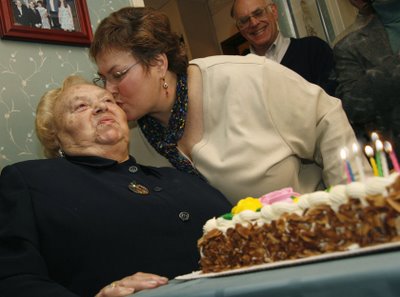As I sat in my car in the school parking lot waiting for Max on his first day of third grade, I saw Bronia for the first time. She could be kind of hard to miss, given that she’s not even five feet tall, but her stride, her sense of self determination, her age, her general presence - well, all of that was difficult to overlook. She was at school every single afternoon to pick up her granddaughter, who was a few years younger than Max, and I would watch her with great curiosity as she moved toward the school doors. Moments later, as she and Rebecca would emerge from school and walk past my car, holding hands, laughing, obviously enamored of one another and happy be to reunited, I caught a glimpse of the number tatooed on her arm, and I wondered more and more about this woman.
I soon learned her name from a friend at the synagogue and began to hear stories about her. Turns out, Bronia was a well known (and well LOVED) icon in Kansas City. She still is.

Bronia was born in 1926 in Turek, Poland. When the Nazis came to Turek in 1940, she was relocated to a ghetto. From there she was sent to three concentration camps, Inowroclaw in 1940, Gnojno from 1941-1943 and Auschwitz from 1943-1944. She then was sent to a labor camp, Reichenbach, on a death march to Zalcweidel, and then to Nederzachsen from which she was liberated in April, 1945. Practlcally every member of her family had perished. After the war, she studied English and worked as a nurse at displaced persons camps in Germany. She came to the United States in June, 1947.
She went on to marry, have four children and several grandchildren. She and her husband owned a bakery. Bronia eventually became a highly requested speaker for local and regional schools and other organizations, telling the tale of her life during the Holocaust. Hearing her story was, and still is, a a compelling moment. Hearing her story can also be a profoundly inspirational and life changing experience.
In 1999, I began a project for the Midwest Center for Holocaust Education. I was given the opportunity to photograph local Holocaust survivors. When I realized I would have the chance to meet Bronia, I was thrilled. I made her portrait at the bakery one morning, but more important, I made a friend who has become an important and enduring force in my life.
I have yet to meet anyone who embraces each day and each person she meets with more gusto than my friend Bronia.

To spend time with this smart, funny, kind and gentlewoman is to get a huge dose of love and laughter (not to mention some great chicken soup, if you happen to visit her around mealtime... scratch that - anytime really). And if you are paying attention, you can also learn an important lesson or two... about things like tolerance, kindness, compassion and love of life.
Today, Eddie and I got to sing to her as she celebrated her 80th birthday with her many friends and family members.

Happy Birthday to Bronia, a real treasure. I count myself as one of the lucky ones whose life has been touched - and changed - by the courage, strength, determination and goodness that defines this very special woman.





















